| Maat-ka-Ra Hatshepsut |
|
2. Portico (Hall of Birth) |
update: 23.01.2012 |
| In the northern wing of the 2. the myth of the birth
of Hatshepsut is told in 15 scenes separated by
vertical lines. However, is the frequently used name "Hall of
Birth" not completely right - it is more a tale of her divine descent
of Amun.
The legend about the divine descent of Hatshepsut is presented in form of flat high relief in the two lower registers of the western wall and the two small abutting walls in the north and the south. Above the two registers there is a report about the "Youth" and the "Enthronement" of the queen. According to Brunner, 1986, both representations have to be regarded as independent from each other. |
|
Like the legend of the divine descent of Amenhotep III in the temple
of Luxor the pictures and the inscriptions in Djeser djeseru show traces of repeated
destruction and restoration. However, here in Djeser djeseru the
destruction of figures and cartouches of Hatshepsut were arranged
by Thutmosis
III (who in the most cases usurped them in the name of his father, Thutmosis II,
but here and again the relief were erased by simply and rough but
"properly matching" hammer
blows) whereas the destructions of Amun are due to iconoclasts from
the Amarna period.
Traces of restoration can be followed until the time of Ramses II who, however, renewed only the pictures of the god(s) but he was not interested in the figures of Hatshepsut. According to Brunner (1986) obviously a lot of duffers were engaged in the restoration work who perfunctory tried to copy the style of the early 18. Dynasty but without any knowledge about the meaning of the pictures and their interdependence. Especially the frequent restoration notes which do not pass over over but over old inscriptions are quite unpleasant. |
| Frequently, the impression is given that Hatshepsut had invented the legend of her divine descent as a legitimation of her reign. According to Altenmüller (Altenmüller , H., "Auferstehungsritual und Geburtsmythos", SAK, volume 24, 1997) this legend, however, can be viewed in the tradition of the so-called "bed scenes" found in private tombs of the Old Kingdom (starting during the 4. Dynasty), which are interpreted as metaphors of a "ritual of resurrection (= Auferstehungsritual)". These "bed scenes" were originally assigned to the sphere of the burial, and refer to the resurrection of the "bedded" deceased in the afterworld - and, if the deceased was a king, also to the admission of the divine king into the realm of gods. |
| To the picture sequence - which is preserved in private tombs of the Old Kingdom - of this "ritual of resurrection (= Auferstehungsritual)" belongs the setting up of a bed in a tent-like building, putting on clean sheets, putting up a headrest (for his wife) on the bed, wiping off the chair on which the owner of the tomb should take place, and, possibly, also the solemn departure of the deceased in a sedan chair. The preparation the bed indicates that the deceased takes over in the "ritual of resurrection (= Auferstehungsritual)" a role associated with "Osiris" (Altenmüller, loc. cit.). In the connection with Osiris the "ritual of resurrection (= Auferstehungsritual)" allows the abolition of death, resurrection and rebirth. The state of death is annulled by sitting on the bed and by the care of his wife who takes over here the role of "Isis". The love of his wife is the medium for the resurrection of the deceased - after successful procreation she reproduces the deceased in his son. |
| Thus, the bed ritual is a "ritual of resurrection (= Auferstehungsritual)", a symbol of rebirth! The development of these "bed scenes" might have accompanied the development of the cult of Osiris during the Old Kingdom. |
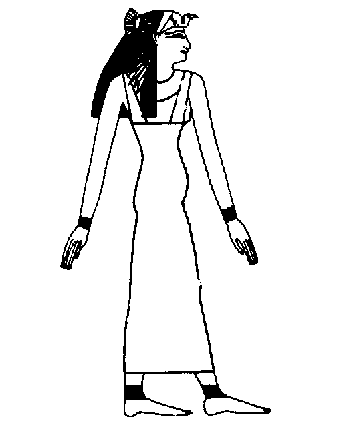
| Deir el-Bahari: pregnant queen Ahmose on her way to the Bower of Birth; from Tyldesley (loc. cited) |
| In the center of the legend of the divine descent is the birth of the divine king whose divine father is Ra in the Old Kingdom (Ra-djed-ef is first, who hold the title "Son of Ra") and Amun in the New Kingdom. The role of the mother is taken over by the actual mother of the divine king. |
| This myth of the divine birth represents one of the essential structures of the Egyptian kingship. The myth can to be viewed - like already mentioned in Djeser djeseru - in Room of Birth of Amenhotep III in the temple of Luxor (according to Brunner the version in the temple of Luxor contains older elements than that one in Djeser djeseru). Fragments of appropriate picture sequence were regained in the Ramesseum and in the temple of Mut at Karnak. Together with others Brunner assumes that the representation legend of divine descend of the divine king belonged to the canon temple relief and only by chance the complete cycles have been preserved in Djeser djeseru and in the temple of Luxor beside the scenes that are fragmentarily preserved in the Ramesseum resp. in the north-eastern temple of the district of Mut at Karnak . |
| Recently Arnold published (Arnold, D., Neue architektonische Erkenntnisse von der Pyramide Sesostris (= Senusret) III in Dashur. Sokar 23-2, 2011) the results of his excavations along the causeway to the pyramid of Sesostris III from 2008 to 2010. The excavations to numerous block fragments brought to light, which allowed a partial identification of the decoration program of the causeway. Several block fragments belong obviously to a sequence of scenes showing the divine descend and birth of the Pharaoh, as we know them from the birth-hall of Hatshepsut's temple at Deir el-Bahari. Thus, we can forget the myth that Hatshepsut let illustrate the birth cycle in order to legitimize their accession to the throne. In contrary, the birth cycle seems most likely had been part of the standard decoration of the royal cult temples. |
| Myth of Divine Birth: |
The birth cycle at Djeser djeseru has the following sequence (all illustrations were taken from Naville, 1894 - 1908; the descriptions and comments of the individual scenes are based on Brunner, 1986). |
| 1a. Amun announces his plan in the
front of the council of 12 gods (in
two registers 5 female and 7 male gods) to father a new
king;
from right to left: upper row : Osiris, Isis, Horus, Nephthys, Seth, Hathor; lower row: Month, Atum, Schu, Tefnut, Geb, Nut; the gods were originally painted in a red-brownish color, the goddesses in light-yellow; this scene (1a + b) completely covers the southern wall |
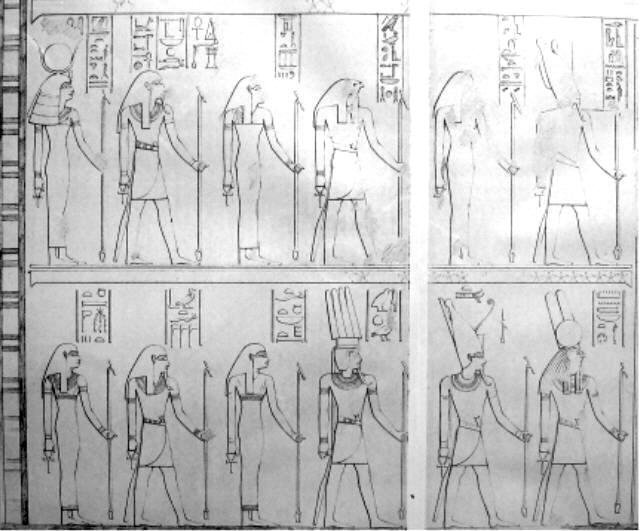 |
| 1b. Amun announces his plan in the
front of the council of 12 gods (on the right side of the scene Amun is sitting on his throne) to father a new
king; vertical in front of Amun a restoration text of Ramses II (see cartouche)
|
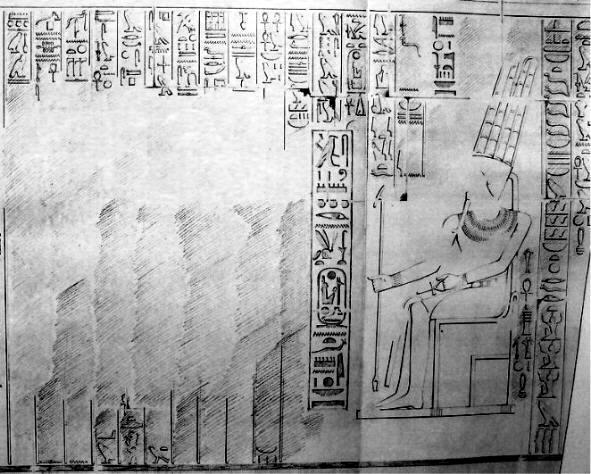 |
| The entire picture cycle has the literary form of the "royal novella", discovered by Hermann (Hermann, 1938). This literary form which was firmly embodied in Egyptian history usually begins with an announcement of the king in which he communicates his ideas to an act to the auditory (a meeting of the council or also the queen, resp.). The members of the council agree and to put his words immediately into action the king appoints a particular agent and and gives him appropriate instructions. The "legend of the divine descent", described here, however, shifts the action, as demonstrated by the first scene, from the royal court to the realm of gods. |
| 2. Amun (left) sends Thot (on the right
side the tip of the nib of the Ibis-headed god is recognizable) to look among
the humans for a woman
suitable as a mother for the king who is to be procreated; Amun looks here in the direction of the picture sequence cycle - i.e. he the one who is arriving (this applies to him and all other gods in all other scenes) here again - in the middle of the scene - a restoration text of Ramses II |
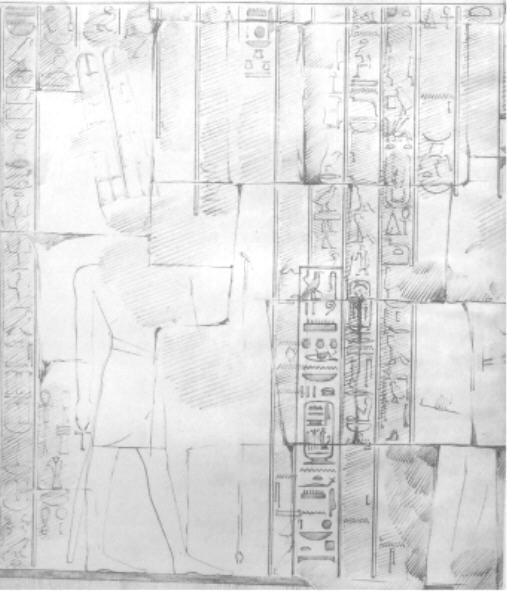 |
| The only figures of this scene, Amun and Thot, are standing opposite to each other. The name of Amun, "Jmn-Ra, nb-nswt-tAwj = Amun-Ra, Lord of all Thrones of the Two Lands" is to be seen in front and above of his head. |
| 3. Thot leads Amun to the
elected mother of the future king, apparently
he has as a scout trace the "location of the queen" or he probably
leads Amun to the desired place ("the royal court at Karnak")
|
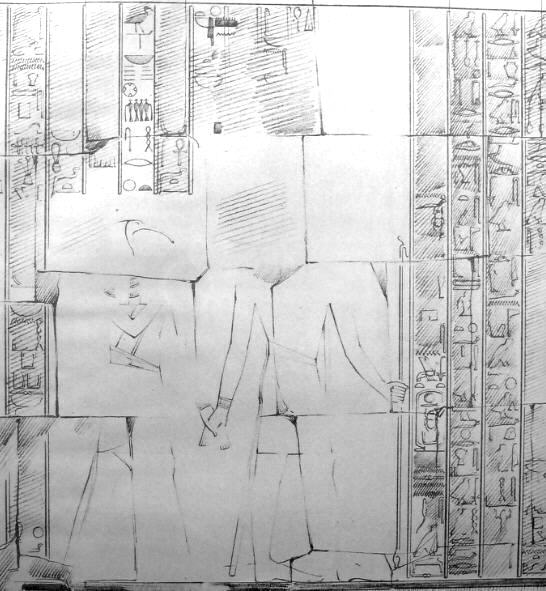 |
| Thot (left figure, the Ibis nib is still well to be seen) and Amun move in the direction of the cycle of the scenes. Since Amun was the higher ranking god in the realm of gods he might have been depicted first although Thot is the leader. However, the artist could have tired also to depict them walking side by side. Above Amun one still sees remains of his name which - regarding the style - was looking to Thot - i.e. it must assumed that Amun had turned his head to the "back" (to Thot). The queen herself is not part of the scene. |
| 4. Intercourse of Amun and the mother of
the future king on the lion bed. On the bed with two lion heads there are two female gods or geniuses sitting who carry the couple, above the left one sits Amun, looking in direction of the cycle, opposite to him is the queen. Thot left the couple alone, so that Amun who approached the queen in the guise of her husband, can unveil himself (as a God) - this and everything else not shown is described in the text |
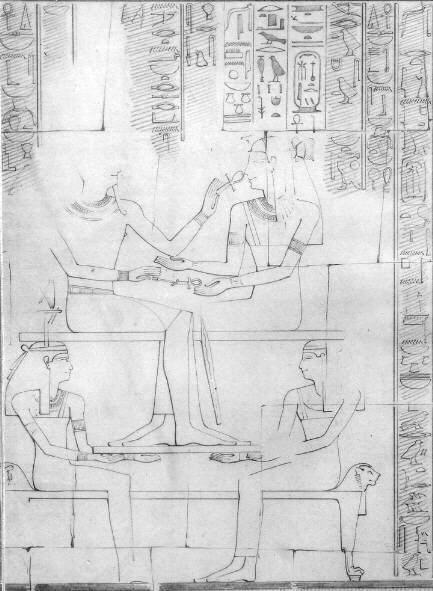 |
| Here again the lion bed is the symbol of rebirth, since it is a representation of Nut, the goddess of the sky, who devours and bears again everything. At a first glance the supporting goddesses seem to Neith and Selket who frequently appear together in the Egyptian religion as protective deities (e.g. on sarcophagi or canopic chests). The just discernible shield with the crossed arrows on the head can point to Neith as well as to Hemuset (s). Brunner described Hemusets as female geniuses, the counterparts of the male Kas, who are involved in procreation or keeping-up life. According to the accompanying texts the figures represent Hemusets. The symbol on the head of the left genius most likely indicates her "contribution" to the event shown. |
| 5. Amun - looking in the
direction of the cycle - instructs Khnum to create a "special body" since it
is a "daughter" in this case. Between both Gods there is a further restoration text of Ramses II |
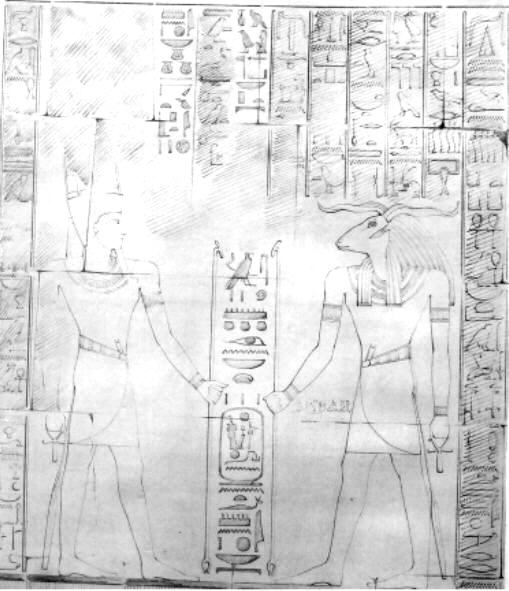 |
| 6. Khnum - sitting on a throne
and looking in the cycle direction - forms the child and its Ka
(both standing on a small table), the frog-headed goddess Heket, kneeling in
front of him,
donates life as indicated by "ankh"-signs. Clearly, both children are definitely of male sex (!), both do not carry the curl of childhood (the checkmark at each head are the ears), but yellow arm stripes at the upper arm and over the wrist. However, since the inscriptions continuously talk of a girl (use of the feminine form of the Egyptian) the actual representation is most likely an error of the restorer (!). |
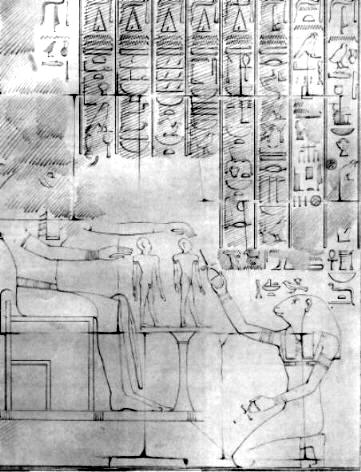 |
| The scene reminds of the well-known coronation scenes in which the kneeling king also turns his back the god while this one is putting the crown on the king's head. |
| 7. Thot announces to queen Ahmose (right with vulture hood) the satisfaction of Amun which is expressed in appropriate titles, thus, among others the inscription calls her: "the comrade he loves", the "Mother of the King of Upper and Lower Egypt". Nothing is said about the child Hatshepsut whose birth and name Amun himself has already announced to the queen in the scene No. 4!
|
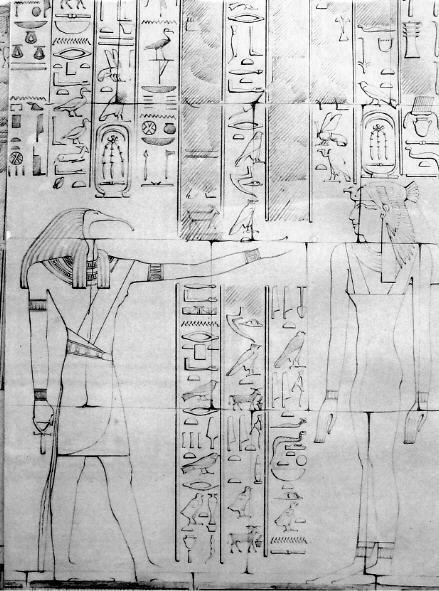 |
| In the view of Brunner the posture of the arm of Thot is another evidence of a copy of the Old Kingdom. To all appearances the left arm of Thot is raised towards the queen but in accordance with the gesture while making an address it must be the right arm. The artist wanted to avoid that the right, resp. rear arm runs rear over the chest. However, this way of representation is limited to Old Kingdom, already starting from the 5. dynasty progressive artists uses the (correct) representation in which the right (rear) arm is raised and runs over the chest. |
| 8. Khnum (left) and Heket (right) lead the
queen, whose pregnancy is suggested "tenderly" for delivery; (this scene was the basis for the drawing used in the Hatshepsut biography published by Tyldesley) |
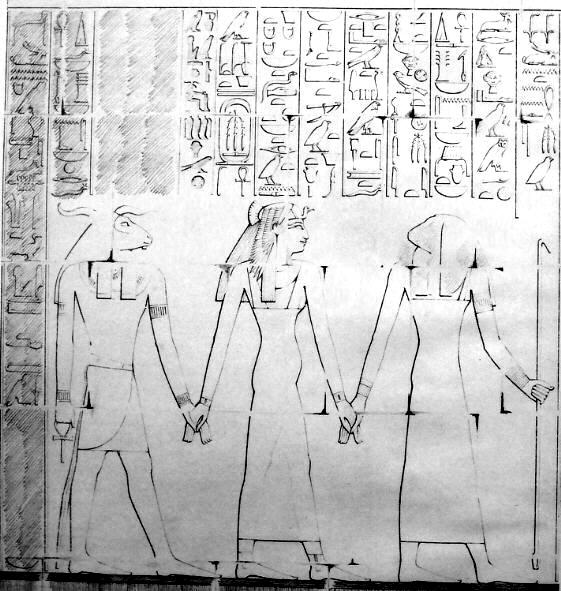 |
| 9a. Ahmose giving birth on the lion bed (left part of the scene), those is
the broadest scene of the cycle showing most of the figures, the
scene is framed by Amun who is left (not shown) and the goddess Mesechnet
(sitting right, see below). Between the two gods the event of
giving birth takes place on a long
lion bed, whereby the queen is shown sitting on a throne not on a
delivery chair; behind her a nurse is kneeling, behind the nurse
there are 4 goddesses standing (from right to left: Nephthys, Isis,
Nedet, Djeret, the name of each goddess is to be seen above her
head); below them on the right of a man with
a divine beard and three further
male figures with crocodile heads;
|
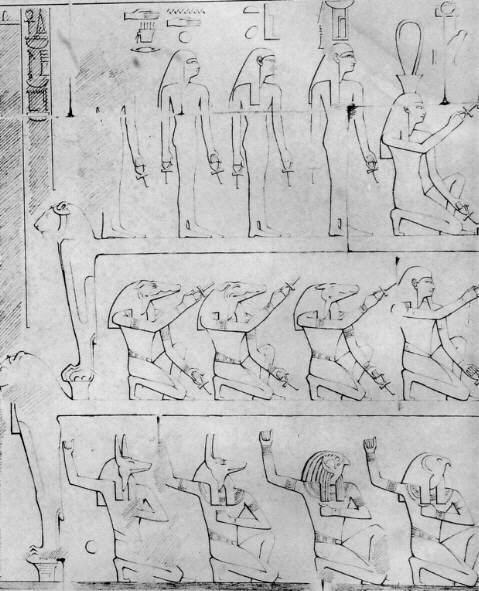 |
| The scene may be somewhat difficult due of the large number of figures but the meaning is clear: the birth takes place in presence of numerous good geniuses. Of interest is the appearance of Nephthys and Isis in the upper row, especially in this strange sequence. Since the legend of the divine descent has no connection to the myth of Osiris, Brunner assumes that both goddesses just represent their aspect of the "Lady of the House". |
| 9b. Ahmose giving birth on the lion bed (right part of the scene), the queen
and the just born child are depicted left above, in front of them a
midwife is kneeling, below the midwife there are two HH-men with long year-signs on the head, then to the right a genius with a crocodile head, followed by 2 men and a ram-headed figure; in the lower row a protection symbol flanked by 2 Uas-signs, on the right Bes followed by a hippopotamus goddess. |
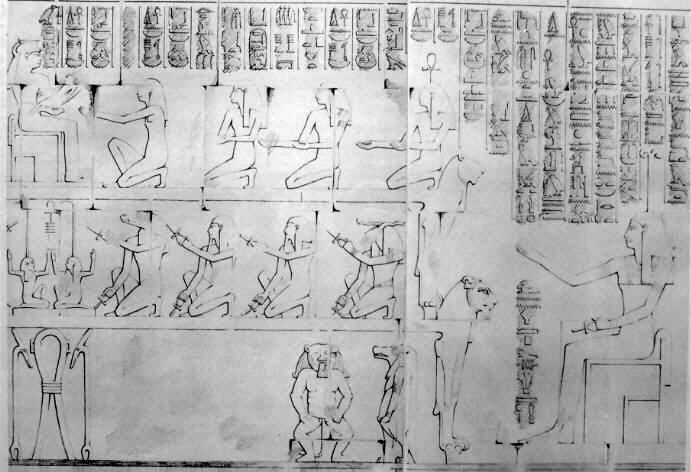 |
| 10. Amun (left) comes to Hathor (right), in order to see and welcome the
newborn child, whereby he approves her expressly as his bodily
daughter and future king;
|
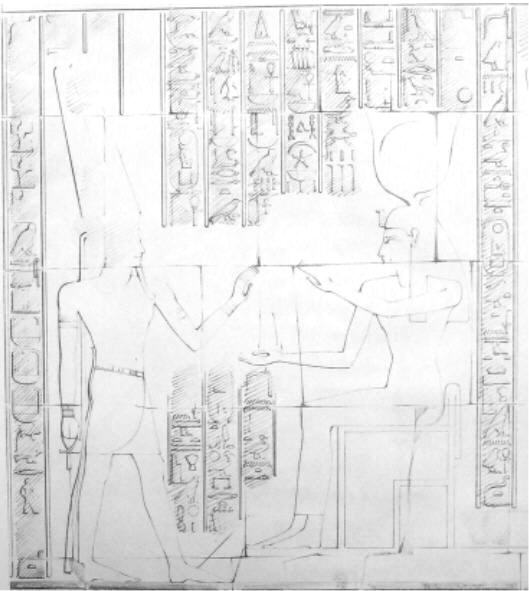 |
| 11. Amun and Hathor (right) sitting
opposite to each other, here, for the first time Amun takes
and holds the child with the left hand to "kiss" and
"embrace" it, since he is "loves her very much"; Hathor repeats the benediction of the father and blesses
the child herself several
times; in Djeser djeseru scenes 10 and 11 were carefully separated and have their own inscriptions; Brunner has assumed that the deviating inscriptions to the scenes 10 and 11 in the temple of Luxor had been placed wrongly - possibly, already at that time the "model" of the legend was not correctly understood anymore |
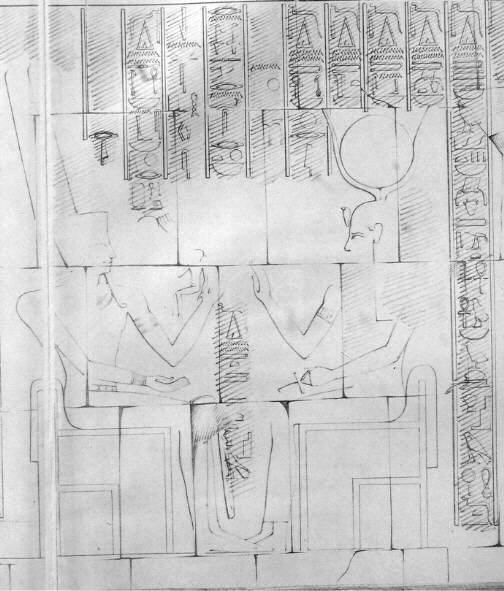 |
| 12a. King's mother and a nurse care for the child on the lion bed (left
part of the scene); Queen Ahmose is depicted in the center of the
scene, behind her
sits a maid, who puts a headdress on her head, opposite to the queen two
completely identical females are sitting both with cow heads, red sun disk and double-feathers, The area below the lion bed is filled out with "tjt"-knots, under the bed, which stands on the sky-hieroglyph, two cows of the heaven are depicted which turn the head backwards. Here two children are missing who were drinking directly at the udder - they were simply omitted by the restorer (however, in the temple of Luxor temple they are still to be seen). |
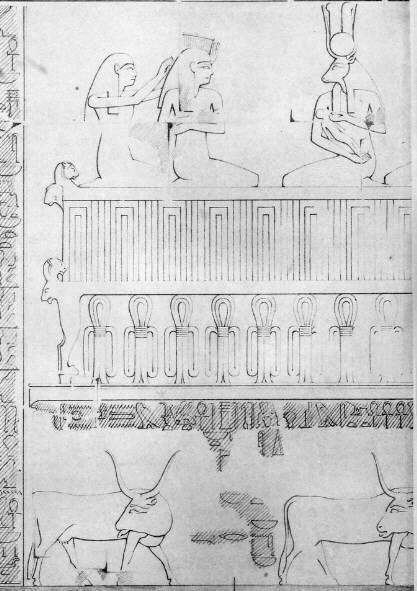 |
| That the scenes 12.a and b belong together is shown by the large sky-hieroglyph which covers both the two cows and the lower four geniuses. |
| 12b. King's mother and a nurse care for the child on the lion bed (right
part of the scene); this part is attached to the scene shown above, here the Ka is nursed by the 2nd female with cow head, sun disk and double-feathers right in three rows alternating male (with beard) and female genius are sitting, four in each row; they are identified as Kas and Hemusets, i.e. as male (Kas) and female (Hemusets) gods of food and meals (s. a. footnote) |
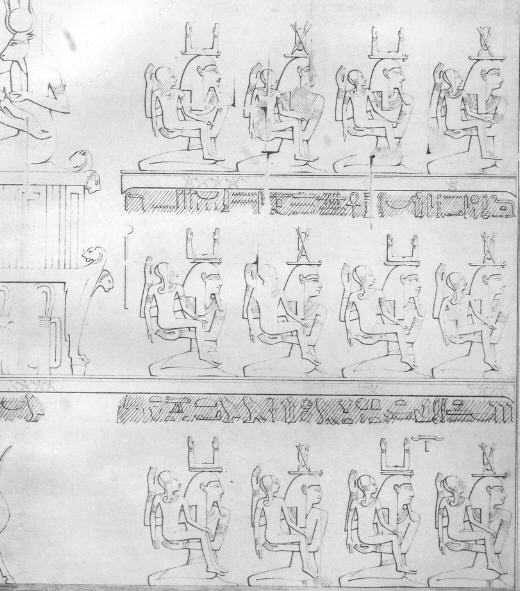 |
| 13. two gods present the child and its Ka
to three anonymous, equal
looking gods in mummy-like dress, who probably symbolize the "Nine
Gods"; the name of the left gods was lost in Djeser djeseru , the one standing in the back could be identified due to the headdress (badges of a milk can which is put in a bowl) as a "Milk-God" called "Iat" (in the corresponding cycle of Amenhotep III in the temple of Luxor the first one is a Nile-God and the one in the back Milk-God); |
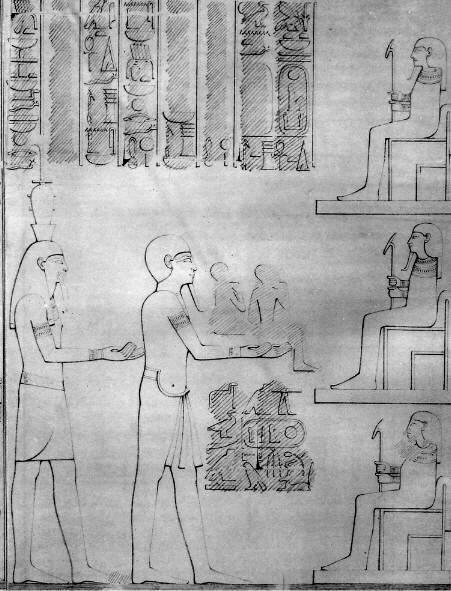 |
| The purpose of the scene is clear, the two Gods bring the child (and its Ka) to the "Nine Gods" not to request their benedictions but to show the council of Gods that Amun had carried out his announcement (made in the 1. scene ). |
| 14. Thot (left) brings the child and its Ka to Amun who blesses both. One still sees the traces of both children who were not repaired during the restoration of the scene. The front figure - on the hand of Amun - is the child, the rear one - on the hand of Thot - its Ka. This is also confirmed by the arrangement of the two cartouches, those of the child is exactly above its head under the center if the winged sun-disk, those of the Ka over its head at the top of a long standard. | 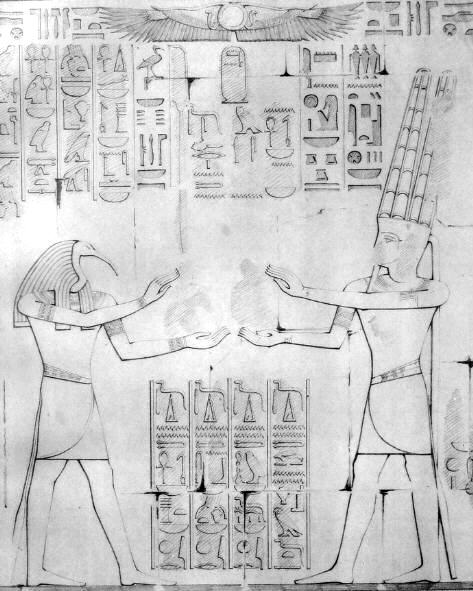 |
| The purpose of the scene is unclear, since in all available versions of the cycle different pictures (e.g. in the temple of Luxor another, not yet identified god is shown instead of Thot) with deviating inscriptions have been preserved. Probably, the scene shows the investiture with the royal dignity, this interpretation may be supported by the winged sun-disk, which is testified since the Old Kingdom (Snofru), above the scene. |
| 15a. "Circumcision"; the scene is clearly split: on the left of (15a) a ram-headed god (Khnum) comes followed by Anubis who is rolling a disk; (s. 15b) Seschat stands on the right side, behind her an unknown god; the center (15b) is formed by 2 double's groups depicted above each other (the lover one has an own heaven with stars above it), in both scenes two women are sitting on the left side, whereby the first one "holds up" the two children, in the upper scene the children are sitting, in the lower one they are standing; one the right side, in front of the children a man is kneeling in the upper scene, in the lower one there is a kneeling woman |
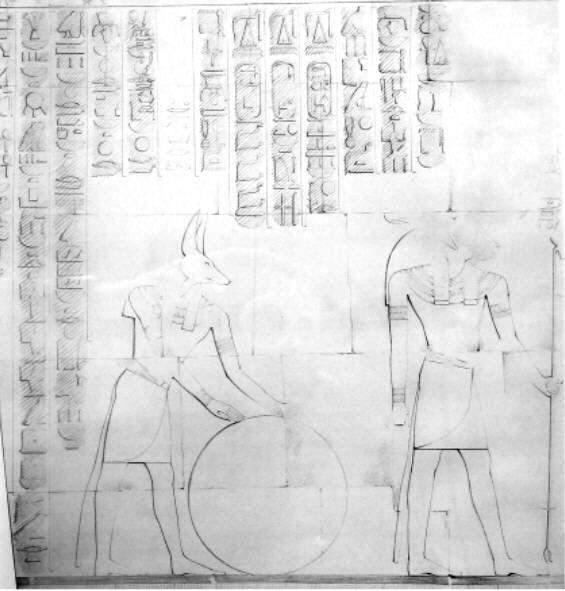 |
| 15b. "Circumcision"
at his time Naville had interpreted this scene as "The duration of the reign of Hatshepsut is written down" (part II, text to Plate LV)
|
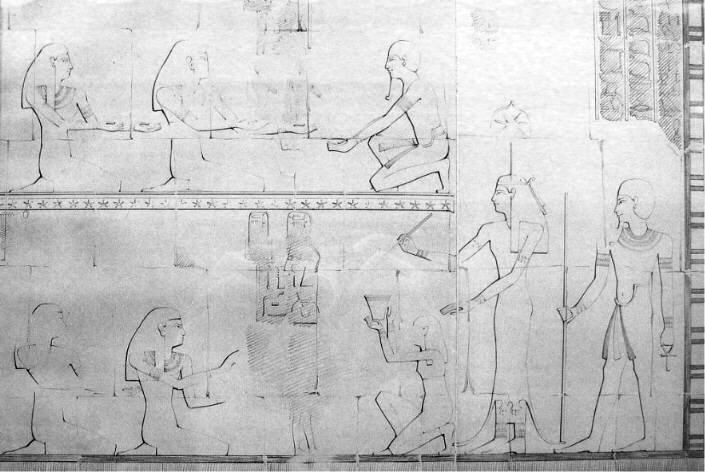 |
| All figures and inscriptions were destroyed, the restorer
had obviously preferred to restore the figures of the gods, therefore the
children are only recognizably in the contours of destroyed figures. Therefore, in both versions that in Djeser djeseru and that in the temple
of Luxor the meaning of this scene was no longer recognizable. Brunner points out that only the version in the temple of
Mut in Karnak made clear that the scene described a "Circumcision". In the upper scene the children are
shown squatting, in the lower one standing, the
women kneeling on the left are holding the children at the thighs. The man
in front of the children kneels, in order to have the correct position for the
operation.
In contrast to that the meaning of the two gods on the right side of the scene, Anubis and Khnum, is less clear. Khnum probably participates in his connection to the house of life, in the inscriptions he is called "the First of the House of Life". However, nothing is known about the disk or ball that Anubis is rolling (in the temple of Luxor this disk or ball completely missing). |
According to Altenmüller H. Brunner has traced back the "legend of divine descent" from the New Kingdom to a model of the Old Kingdom, whereby apart from age criteria for the figurative expression and for the accompanying texts Brunner pleads for a development before the 4. Dynasty. Among others Brunner, 1986, has put forward the following reasons: - the drawings of the bed in scenes Nos. 4 (fathering), 9 (delivery) and 13 (presentation of the child) obviously go back to early representations of the bed (with top view on the surface of the bed) which did not appear any longer after the era of the early pyramids - the title "mwt njswt bjtj" ("Mother of the King of Upper
and Lower Egypt") in scene No. 7 (announcing the delivery) was used only in the
Old Kingdom - the Kas and Habs (s. a. footnote) in the scene No. 12 (the king's mother and nurses care for the child on the lion bed) appear in Luxor in this composition only in the "Pyramid Texts" - the absence of any reference to the myth of Osiris. |
| The representation of the "legend of divine descent" appears exclusively on temple walls (2 example in the temple of Hatshepsut (Djeser djeseru) and that of Ramses II (Ramesseum); 2 further from the temple of Luxor and Karnak). This clearly points to the fact that the "world" of the "legend of divine descent" is the realm of gods (it is uncertain what the version Mut-district of Karnak is telling, however, the presence of two erased cartouches in the scene No. 7 point to the procreation and birth of a divine king; in each case it is most likely the latest version - probably dating from the 21. or the 22. Dynasty). However, for the divine king the realm of gods becomes his residence only after his death what again leads to the statement that the "legend of divine descent" was not meant for the living king but for the deceased one in the afterworld. This also explains why in the "legend of divine descent" reports about the birth of an enthroned and crowned king. The event represented in the scenes of the cycle is the repetition of the real birth of the divine king in the realm of gods. |
Thus, the "legend of divine descent" of the divine king does not serve - also not in the case of Hatshepsut - as a legitimation of the reign of the divine king in whose temple it is presented. The frequently - especially by males - voiced suspicion was that Hatshepsut had invented or exploited the "legend of divine descent" in order to legitimize her weak claim to the throne. This suspicion is only worth a discussion if one finds an explanation which "weak" claim for the throne had forced Amenhotep III (in Luxor temple) and Ramses II (in the Ramesseum) on their part to exploit the "legend of divine descent". The "legend of divine descent" thus reported exclusively about the rebirth of the divine king in the afterworld and therefore, it has its place in the cult. |
| Djeser djeseru | Location of the Monument | History | Djeser djeseru - the times after |